|
|
|
|
|
|
|
|
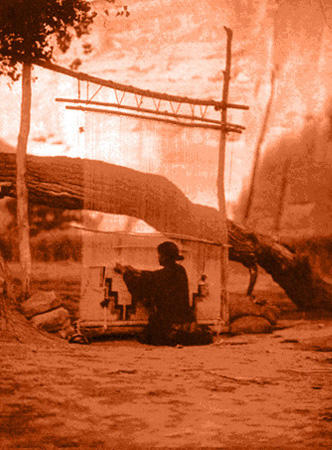 |
Curtis’ Navajo Blanket Weaver 1904 This shows a Navajo woman at work, sitting on the earth and weaving her blanket diligently. Hanging down on a loom, simply constructed with a few tree branches, the unfinished part of the blanket appears like a screen in midair. The scene is tugged neatly at the bottom as part of a big tree. Behind the loom, there is a part of the tree that curves toward the earth. It is difficult to tell whether it’s a branch or part of the root. Its form appears like an arm surrounding the weaver and her loom. Through Curtis’ lenses, this arm becomes the arm of Nature nurturing the weaver. Transcending the scenery further, the air surrounding the tree and the weaver seems to glow with a mysterious aura. In the distance, partly hidden in the fog, the landscape forms a big palm against the sun as if to protect the weaver like a mother would her child. |
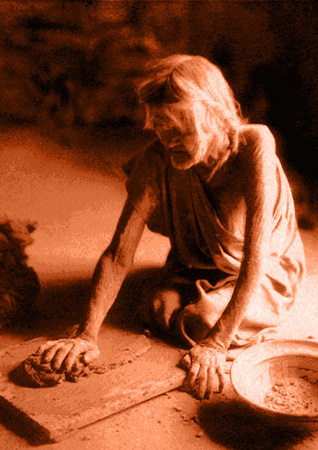 |
CoestañHopi Pottery Maker 1904 Here, Curtis depicts an old woman working with clay in her cave-like home from the Tewa village of Hano in the eastern part of Hopi territory. About this dramatically lit photograph, Curtis only commented: ìThis woman, so aged that her shriveled skin hangs in folds, still find pleasure in creating artistic and utilitarian pieces of pottery.î 1 In almost all cultures, the elderly is respected by the young, following the simple concept that age confers experience and wisdom. As this woman glows in reflection of her age, the light hints at the end of life. The fact that she is working with clay implies the process of returning to the earth. As she was born from the Mother Earth, she would return to her mother at the dusk of her life. The light casts her shadow on a fresh lump of clay, perhaps to hint at reincarnation. Regarding Hano clay, Curtis wrote in volume 12 of The North American Indian:ìWhen thoroughly dry, it was ground on the milling stones and then soaked in water before it was mixed with pulverized sandstone or potsherds. This mixture was then thoroughly kneaded before it was shaped by hand into a pot.î 2 If on her left hand lays the pulverized sandstone and on her right, the Hano clay, then her hands indubitably act as creator of a new mixture, giving the clay its shape and form. Thus, in this instance, the old womanóa potteróalso acts as creator or the mother. She creates pots and clayware just as the Mother Earth has created her. A child and yet at the same time a mother, the old woman and Nature exist as one when they both take part in the creation of pottery. |
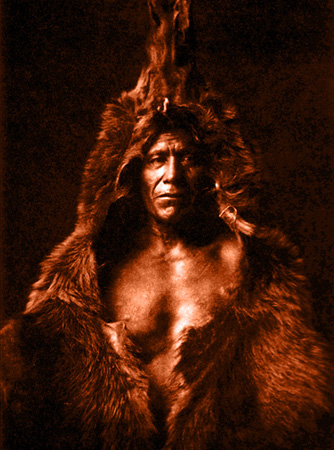 |
Bearís BellyñArikira 1908 In medical practice, Native American communities relied on the gathering of herbs and animals. In many instances, the herbs and animals contained the power to cure the illness of the body and also of the spirit. Believing in the healing power of certain animals or birds, some individuals would wear part of their remains as headdresses like in the case of Medicine Crow ñ Apsaroke, 1908 3 or as garment like in the case of Bearís Belly ñ Arikira, 1908 4. In all cases, they treated the animal parts as part of their body. This practice shows their bond with other creatures in Nature and further demonstrates the Native Americansí awareness of the surrounding environment. |
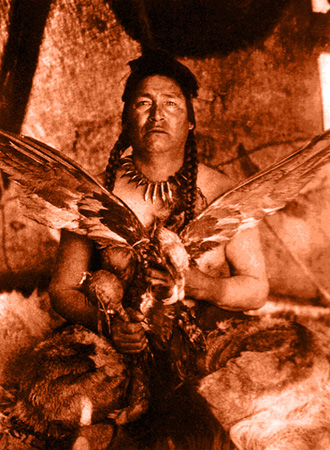 |
Placating the Spirit of a Slain Eagle 1900s This photograph shows a man spreading a dead eagle across his chest while chanting in prayers. Eagle hunting as noted by Gidley in The Vanishing Race involves long religious rites. The Sarsi tribe required the hunting party to work together as actions of individuals affect the whole party. When the eagles are captured, the hunter and the family welcome the eagles as if they were children of the family. The laying of eagle corpses involves reiteration of the phrase, |
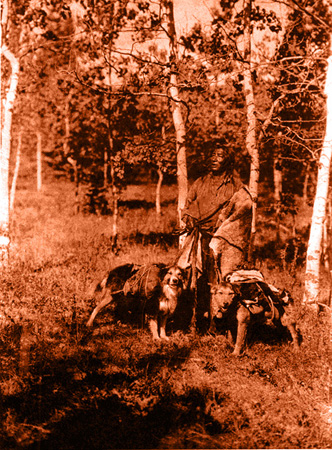 |
Hunter, Assiniboin Hunter 1904 Oftentimes, people think of hunting as an act of killing or taking away the lives of the prey. However, in Hunter, Assiniboin Hunter we see a different message. In ancient archaeological symbolism, a female flanked by two animals, especially felines, is interpreted as a depiction of the fertility goddess such as Astarte. 6 Here, Curtis depicts a well aged hunter flanked by his canine companions. While the canines look toward us, the hunterís face angles upward to the left, where there seems to be a source of light. This light source not only highlights the hunterís face but at the same time bathes the whole forest in light. For a moment, it seems like the hunter has transcended into a realm of the deity. He no longer takes life but is rather taking part as a member of the course of Nature. In taking the life of his prey, he removes a predator of many other species. In removing a predator, he saves and gives back the lives of many species. Thus, while taking something from Nature, he is giving back something else in the end. This act of giving can be compared to that of the goddess who blesses human with the gift of fertility. It is, however, uncertain whether Curtis meant to depict this hunter in reference to the ancient symbol of goddess of fertility. Even if he did not mean so, the photograph would still be a depiction of a noble hunter and his close relationship with Nature. |
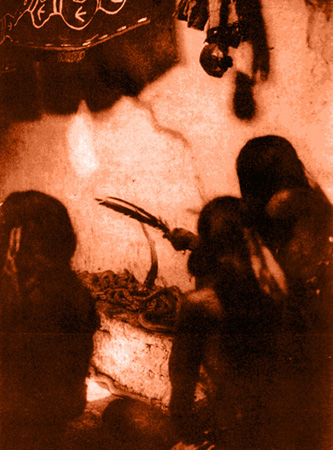 |
HopióSinging to the Snakes 1900s Religious rituals of Native Americans were often read as their communication with the Great Mystery. Tribal priests often performed sacred rituals where they communicated with animals such as snakes or turtles. In some instances, they also communicated with the Great Mystery through natural signs such as meteors or lunar eclipses. In HopióSinging to the Snakes, Curtis depicts a scene in which three snake priests are communicating with snakes. Here, by showing only the backs of those priests, Curtis seems to take a step back as if he is accepting his ignorance of the tribal priestsí ability to communicate with creatures in Nature. It is not often that we see him standing back taking the role of an onlooker rather than a member of the event. Perhaps Curtisí silent acceptance is meant to acknowledge the fact that we can no longer communicate with Nature like our ancestors. |
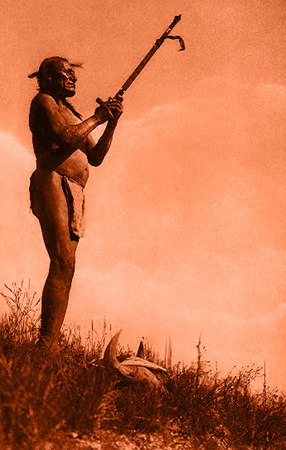 |
Prayer to the Great Mystery 1900s Curtis also produced a series of photographs of a Sioux medicine man praying to his maker and titled it Prayer to the Great Mystery. Regarding this series, Hausman and his colleagues summarized it nicely in the introduction to their book: To the Sioux and the other Plains people, the buffalo was a symbol of all good given by the Creator. Thus, the skull, raised to the sun in such a way, was neither question nor answer; but rather a simple act of faith. It did not matter that the great herds were, as Curtis put it, ìswept from the earth as in a twinkling.î For the elders to whom he spoke were convinced of but one thing: the Great Mystery. And what the Great Mystery took away, He would, one day, return. 7 The Great Mystery or the Creator in Native American has a deep relationship with Nature. As stated, the Great Mystery gives tribal communities their necessities. He gives them vegetation and animals for food and medicine. He also creates the environment in which they exist. It seems that what the Native Americans called the Great Mystery is simply a name that stands for all things in Nature. Their relationship with Nature, then, is rooted in respecting and worshiping the way Nature motherly nurtures their tribal communities. |

|
1 Alan Bisbort and Sara Day, Heart of the Circle (San Francisco: Pomegranate Artbooks, 1997), 61. 2 Curtis as quoted in Heart of the Circle, 61. 3 Barbara A. Davis, Edward S. Curtis ñ The Life and Times of a Shadow Catcher (Tokyo: Dai Nippon Printing Co. Ltd., 1985), 114. 4 Davis, 123. 5 Mick Gidley, The Vanishing Race (New York: Taplinger Publishing Co., Inc., 1977), 152. 6 Johanna H. Stuckey, Astarte Goddess of Fertility, Beauty, War and Love http://www.matrifocus.com/IMB04/spotlight.htm viewed on May 6, 2005. 7 Gerald Hausman and Bob Kapoun, Prayer to the Great Mystery: The Uncollected Writings and Photography of Edward S. Curtis (New York: St. Martinís Press, 1995). |